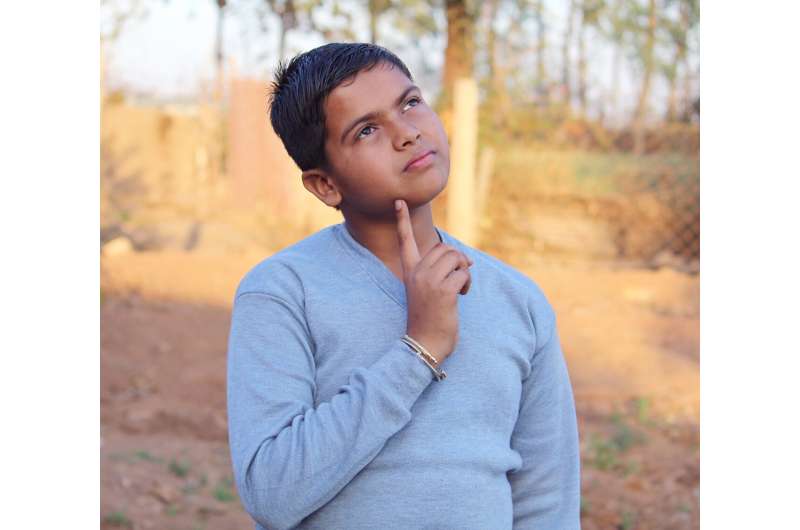This article has been reviewed according to Science X's editorial process and policies. Editors have highlighted the following attributes while ensuring the content's credibility:
fact-checked
peer-reviewed publication
trusted source
proofread
Measuring children's looking behavior yields new tool to help diagnose autism earlier

Results of clinical studies published simultaneously in the Journal of the American Medical Association (JAMA) and in JAMA Network Open demonstrate that measuring children's looking behavior predicts expert clinical diagnosis of autism in children between ages 16 to 30 months tested with a high degree of accuracy.
According to researchers from Marcus Autism Center, a subsidiary of Children's Health care of Atlanta, this new tool can help clinicians diagnose autism earlier while also providing objective measurements of each child's strengths and vulnerabilities, to help jumpstart effective support for child and family.
"The results show that the way in which young children look at social information can serve as an effective and objective biomarker for early signs of autism," says Warren Jones, Ph.D., lead author, Director of Research at Marcus Autism Center at Children's Health care of Atlanta and Nien Distinguished Chair in Autism at Emory University School of Medicine.
In early trials of the device, researchers frequently referred to the biomarker technology as "the Marcus Test" for autism, acknowledging the leadership of philanthropist Bernie Marcus in giving to autism research and treatment over the past 35 years, including the founding of Marcus Autism Center. One of the crowning achievements of his life's work in autism has been the development of the tool diagnose children earlier and get them into treatment sooner.
Autism affects 1 in 36 children, meaning that each year, in the U.S. alone, more than 90,000 children with autism are born. Early identification and early intervention are important for supporting the health, learning, and long-term well-being of all children with autism.
For more than two decades, Dr. Jones and co-author Ami Klin, Ph.D., Director of the Marcus Autism Center at Children's Health care of Atlanta, have studied "social visual engagement"—how children look at and learn from their surrounding social environment—and how this differs in children with autism.
Past research showed that these differences emerge early in infancy and are directly related to individual genetic differences. In their current work, Drs. Jones and Klin developed technology to reliably measure these differences as a biomarker for clinicians to use.
"The far-reaching implications of these results may mean that children who currently have limited access to expert care, and face two or more years of waiting and referrals before finally being diagnosed at age four or five, may now be eligible for diagnosis between the ages of 16 and 30 months," said Dr. Klin, who is also Division Chief of Autism and Developmental Disabilities at Emory University School of Medicine.
"In addition, this technology measures each child's individual levels of social disability, verbal ability and non-verbal learning ability, which is critical information for clinicians when developing personalized treatment plans to help each child make the greatest gains."
Clinical studies of more than 1,500 children show efficacy
Research published in JAMA Network Open describes the initial development of the technology, with results from more than 1,000 two-year-old children in discovery and replication studies. Data published in the Journal of the American Medical Association (JAMA) describe results from a multi-site trial at six of the nation's leading centers for autism diagnosis and treatment, using automated devices to test approximately 500 children between the ages of 16 to 30 months.
In each of these studies, the researchers tested whether automated measures of children's looking behavior could effectively predict results of diagnostic assessments conducted by highly trained, expert clinicians.
During testing, children watched video scenes of social interaction. As they watched, their eye movements were monitored at a rate of 120 times per second to determine, moment-by-moment, what social information the children looked at and what they did not. After collection, tens of thousands of these measurements were compared to data from age-matched peers, using algorithms to quantify similarities and differences at each moment in time.
These measurements were summarized to provide an overall diagnostic indication as well as individual measurements of each child's levels of social disability, verbal ability, and non-verbal learning skills.
When compared with expert clinical diagnosis of autism at six of the nation's leading centers, automated measurements of children's looking behavior accurately matched the current gold standard, which could help pave the way for earlier, objective diagnosis in many children.
"Objective, performance-based biomarkers can help clinicians diagnose and support more children and families, with the same level of clinical confidence. We hope this can alleviate current burdens on the health care system and reduce lengthy waitlists for assessment," said Dr. Jones.
"When we can shorten the time from parents' first concern to diagnosis and the start of beneficial support, we can help positively impact the lives of many children and families."
More information: Journal of the American Medical Association (2023). DOI: 10.1001/jama.2023.13295. jamanetwork.com/journals/jama/ … 1001/jama.2023.13295
JAMA Network Open (2023). DOI: 10.1001/jamanetworkopen.2023.30145. jamanetwork.com/journals/jaman … tworkopen.2023.30145



















